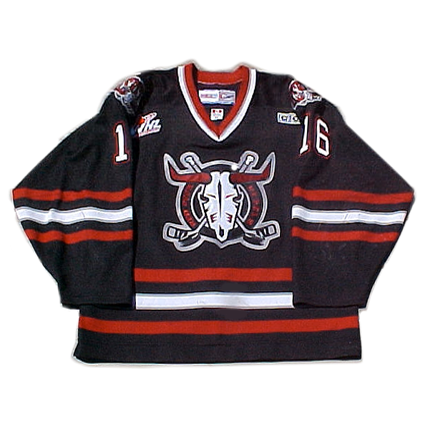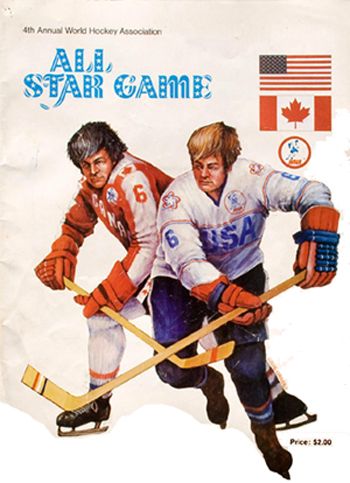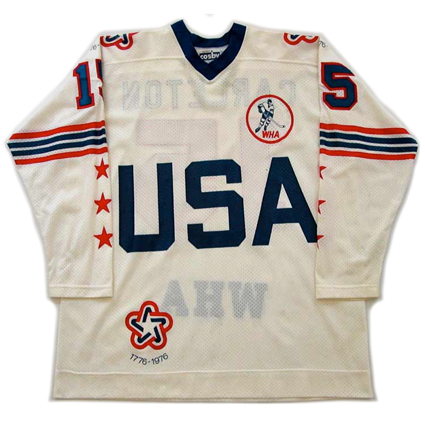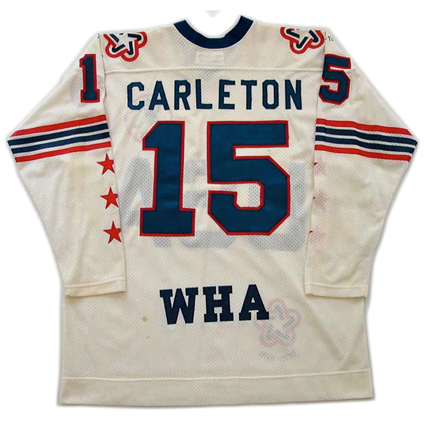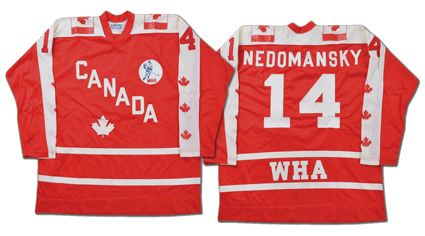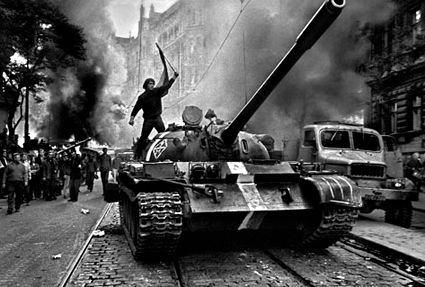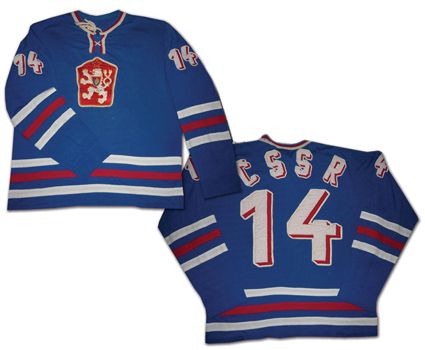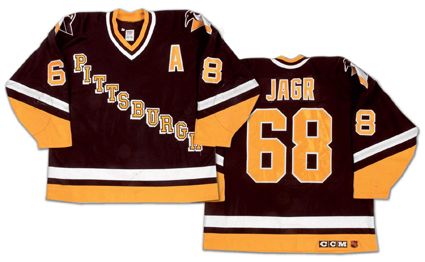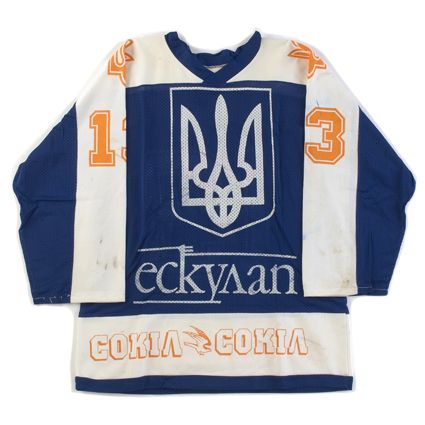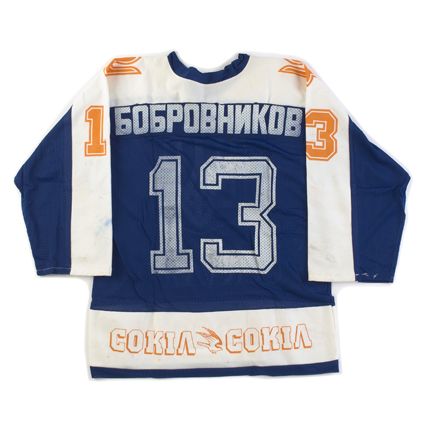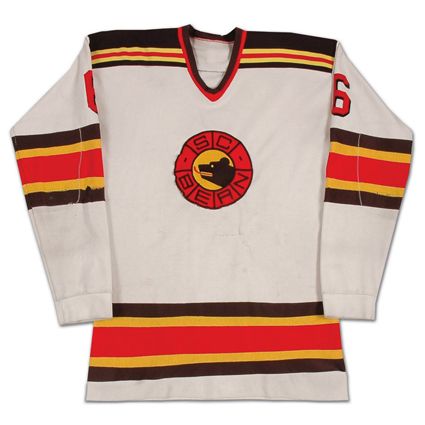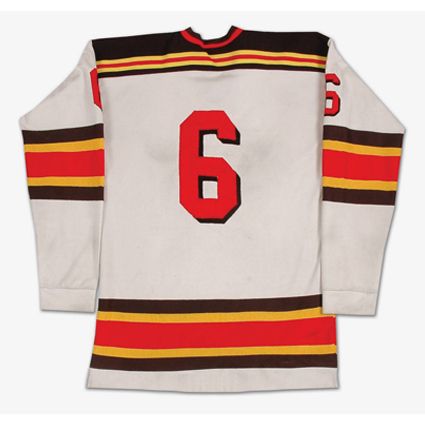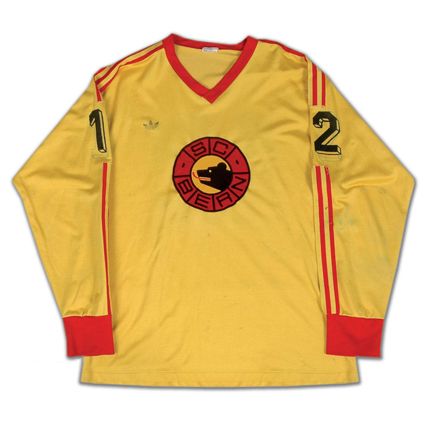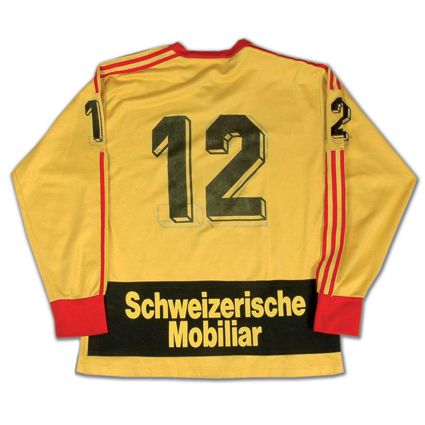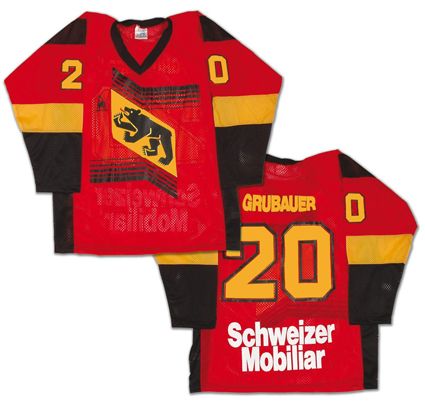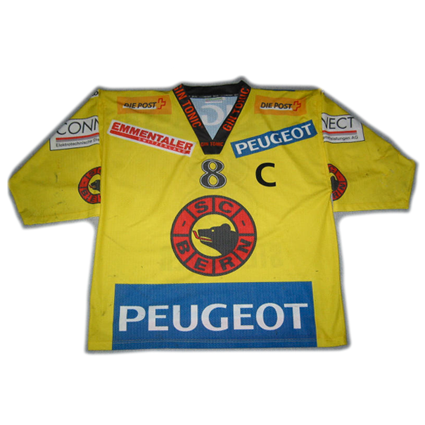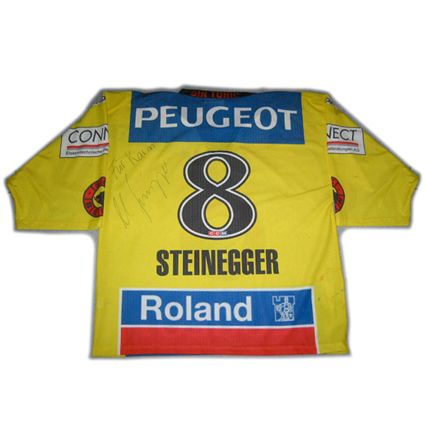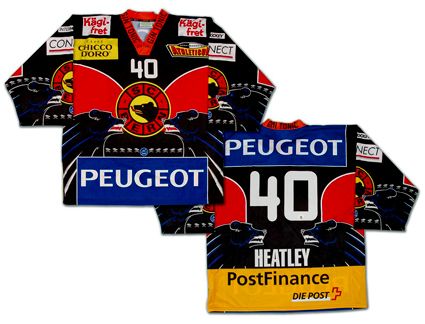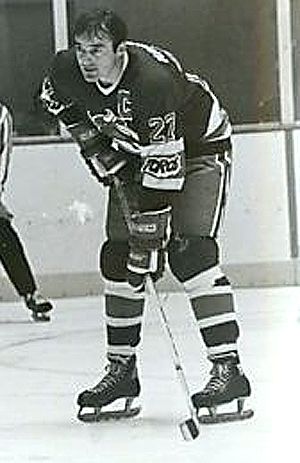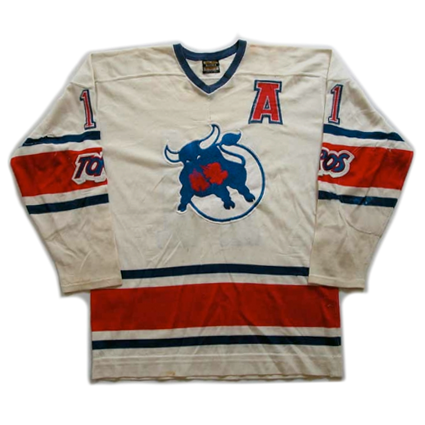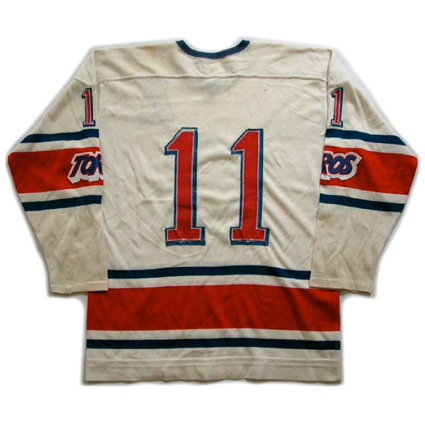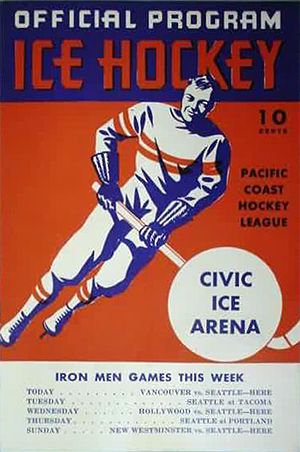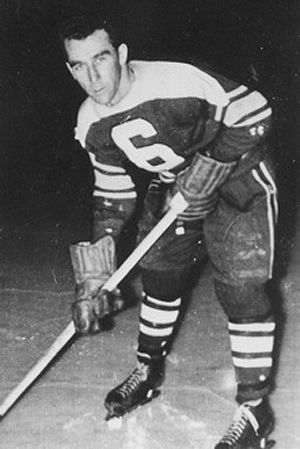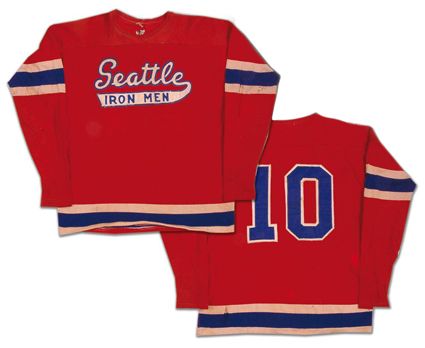Saturday, July 16, 2011
2000-01 Red Deer Rebels Derek Endicott Jersey
July by the Numbers travels to western Canada for jersey #16.
Members of the Western Hockey League since their founding in 1992, the Red Deer Rebels took five seasons to achieve their first winning record in the 1996-97 season when they finished at 43-26-3. After a step back the following season, Red Deer (which is located midway between Edmonton and Calgary) began a run of seven consecutive winning records in 1998-99.
They admittedly started slowly with two seasons barely above .500, but stormed through the league in 2000-01 with a league best 54-12-3 record, led by WHL scoring champion Justin Mapletoft's 43 goal, 120 point season, while teammate Kyle Wanvig was sixth in the WHL with 101 points.
Red Deer cruised to the WHL title with a 16-6 playoff record to earn a place in the 2001 Memorial Cup. They opened with a 5-4 overtime win over Val D'Or and downed Ottawa 4-2 before dropping a game to Regina 5-2. Still, their place in the final was set, and they defeated Val D'Or once again in a 6-5 overtime thriller to win the first Memorial Cup in franchise history.
The 2001 Memorial Cup champion Red Deer Rebels
Two more strong seasons followed, including once again having the league's best record in 2001-02 at 46-18-7 and another 50 win season in 2002-03, but were unable to repeat as WHL playoff champions.
Starting in 2005-06 the Rebels would miss the playoffs three out of four seasons, but they would rebound in 2010-11 with their third Central Division title after being led in scoring by Ryan Nugent-Hopkins, who went on to become the first player from Red Deer ever taken first overall in the NHL Draft.
Nugent-Hopkins joins a list of Rebels taken in the first round of the NHL Draft along with Colby Armstrong, Boyd Gordon, Dion Phaneuf, Brandon Sutter, Cam Ward and Jeff Woywitka. Other recognizeable Rebels to have played in the NHL include Martin Erat, Colin Fraser, Darren Van Impe and Kris Versteeg.
The Rebels are currently owned by Alberta native and former NHLer Brent Sutter, who also spent seven seasons as the club's head coach and general manager, including their Memorial Cup winning season of 2000-01.
Today's featured jersey is a 2000-01 Red Deer Rebels Derek Endicott jersey. This jersey has a classic look, with a basic template quite similar to the Chicago Black Hawks white jerseys thanks to it's three equal width stripes on the arms and waist. Paired with the spooky main crest which features a steer skull logo, which was adopted in 1997, the overall package makes for an excellent look.
Today's video is about Nugent-Hopkins prior to the 2011 NHL Draft showing him in a variety of Red Deer Rebels jerseys.
Labels:
Red Deer Rebels
Friday, July 15, 2011
1975-76 Team USA WHA All Star Game Wayne Carleton Jersey
July by the Numbers returns to North America for jersey #15.
When the World Hockey Association held it's first three All-Star games in the early 1970's they held to the traditional East vs. West format, but for the 1976 game, a change was made on the occasion of the bicentennial of the United States.
The format for the 1976 WHA All-Star Game pitted the All-Stars from the teams based in the US against the All-Stars from the franchises located in Canada. This was not the same as the "World vs. North America" format first used for the 1997 NHL All-Star format where the players were divided based on the location of each players nationality, but the location of the franchise for which they played.
1976 WHA All-Star Game Program
A quick glance at the WHA standings would suggest that the United States team would have a distinct advantage since there were nine US based teams from which to draw players, while the Canadian based teams numbered just five.
The division of players by club location certainly made for a mixed, if not confusing and absurd pair of rosters, as Canadians Gerry Cheevers, Paul Shmyr, Pat Stapleton, Kevin Morrison, John Schella, Rick Ley, Andre Lacroix, Gene Peacosh, Gordie Howe, Dave Keon, Claude Larose, Mike Walton, Wayne Carleton, Ralph Backstrom, Tom Webster and Don Borgeson and Swede Christer Abrahamsson made up Team USA along with just three actual Americans, Marty Howe, Mark Howe (who were born in Michigan while their Canadian father Gordie played for the Detroit Red Wings) and Massachusetts native Robbie Ftorek.
Meanwhile, Team Canada consisted of 14 Canadians as well as Swedes Lars-Erik Sjoberg, Thommie Bergman, Anders Hedberg, Ulf Nilsson and Czechoslovak Vaclav Nedomansky!
The contest was played in Cleveland, Ohio, home of the Cleveland Crusaders and was witnessed by a healthy crowd of 15,491. Despite the perceived advantage of having a larger talent pool to pick from, the "Americans" fell to Team Canada by a lopsided 6-1 score. Team Canada MVP was Canadian Real Cloutier following his hat trick, while Team USA MVP was Crusader (and Canadian) Shmyr.
1976 WHA All-Star Game Ticket
Today's featured jersey is a 1975-76 Team USA WHA All-Star Game Wayne Carleton jersey. This lightweight mesh jersey has the WHA logo on the upper left chest and the American Bicentennial logo on both shoulders and the lower right front of the jersey.
It's actual decoration in minimal, with four narrow sleeve stripes and a trio of stars down each arm. The simplistic block USA on the front and the lack of waist stripes gives the jersey a stark appearance, not unlike that of a modern practice jersey.
Bonus Jersey: Today's bonus jersey is a 1975-76 Team Canada WHA All-Star Game Vaclav Nedomansky jersey. This red mesh jersey is more successful in appearance than the USA version, with it's Canadian flags on the shoulders, diagonal "Canada" across the front, adorned with balanced WHA and a maple leaf logos on either side, as well as maple leafs running down each arm and a pair of waist stripes. While it scores no points for originality, as it is essentially a copy of the 1974 Summit Series jersey with some detail differences, such as two waist stripes rather than three, it is still a pleasing effort all around.
Labels:
WHA
Thursday, July 14, 2011
1969 Czechoslovakia Vaclav Nedomansky Jersey
July by the Numbers travels behind the Iron Curtain for jersey #14.
The Prague Spring began in early January of 1968 when Alexander Dubček came to power in communist Czechoslovakia, beginning in a period of liberalization in which Dubček attempted to grant greater freedom by loosening restrictions on the media, art, speech and travel. These reforms did not go over well with the Soviets, who eventually invaded Czechoslovakia and it's capital of Prague with approximately 750,000 troops from the Warsaw Pact (the Soviet Union, Bulgaria, East Germany, Hungary and Poland) on August 20, 1968 which resulted in 108 Czech and Slovak deaths and 500 injuries to primarily civilians. Despite being arrested and taken to Moscow, Dubček was allowed to remain in office and was returned to Prague a week later.
Dubček remained in his position until April of 1969 when he was forced to resign following the Czechoslovak Hockey Riots, which took place in response to the 1969 World Hockey Championships.
Originally scheduled to be held in Prauge, the 1969 World Championships were moved to Stockholm, Sweden due to the invasion and began on March 15th, when the Czechs defeated Canada by a resounding 6-1 score. Sweden beat Finland 6-3 and the Soviet Union destroyed the United States with a 17-2 pummeling also on day one which would prove vital later in the tourament. Entering the tournament the Soviet Union had won the last six World Championships as well as the last three out of four Olympic Games.
On March 21st, the Czechs and Soviets met in day six of the tournament with the Soviets at 4-0 with a 34-6 edge in goals scored up to that point, while the Czechoslovakians were 3-1 following a 2-0 loss to Sweden.
To the Soviet team this was just another hockey game, but not to the Czechs. With 70,000 Red Army soldiers still occupying their country, it was about much more than just hockey.
“We said to ourselves, even if we have to die on the ice, we have to beat them,” said team captain Jozef Golonka many years later. “We received hundreds of telegrams from fans back home when we arrived in Stockholm. Almost all of them said: ‘Beat the Soviets. You don’t have to beat anyone else. Just beat the Soviets.’”
Following a scoreless first period, defenseman Jan Suchý scored his fifth goal of the competition at the 13 minute mark of period two to put the Czechs on top. Josef Černý added a second goal at the seven minute mark of the third period while legendary goalkeeper Vladimir Dzurilla held the Soviets at bay for a 2-0 shutout, sending thousands of Czechoslovakians into the streets back in Prague in celebration.
The Czechs then wrapped up three more wins until they were matched up against the Soviets for the second time, as the tournament format was for each of the six teams to face the other five two times each. The Soviet Union meanwhile marched through their three subsequent games as expected, setting up the rematch with both teams now at 7-1.
Jiří Holík opened the scoring at 15 minutes to put the Czechs ahead 1-0 after one. Vaclav Nedomanský gave the Czechs a 2-0 lead in the first minute of the second, but Valeri Kharlamov responded for the Soviet Union two minutes later and Anatoli Firsov tied the game at the 13 minute mark.
Josef Horešovský delighted the Czech fans with a go-ahead goal at the nine minute mark of the third period before Jaroslav Holík sent them into rapture with another Czech score just two minutes later. Alexander Ragulin got one back for the Soviets with less than two minutes to play, but it was not enough as Czechoslovakia held on for a 4-3 win, becoming the first team to ever defeat the Soviet Union twice in a single IIHF tournament.
Once again, a reported half a million Czechoslovakians took to the streets across the country in what was first a celebration of their hockey team's victory, but, particularly in Prague, evolved into a protest against the Soviet military which had continued their occupation of Czechoslovakia since the previous August.
From Time Magazine April 11, 1969:
Overcome by a vicarious sense of triumph, a huge and excited crowd swarmed into Prague’s Wenceslas Square. One happy hockey fan carried a poster that read BREZHNEV 3, DUBČEK 4. The crowd chanted, “We’ve beaten you this time!” Someone shouted, “The Russian coach will go to Siberia!”
Those particular protests turned violent when not only Soviet military units were attacked and their vehicles burned, but the offices of the Soviet airline Aeroflot were ransacked.
The uprising was suppressed by the Czech military, which was now under control of hardliners from the Communist Party, and the events were used as a pretext to oust the remaining leaders of the Prague Spring from power, Dubček in particular.
Heading into the final two days of the tournament, Czechoslovakia led with an 8-1 record, while the Soviet Union, thanks to their two losses to the Czechs were 7-2 and Sweden was 6-2 after a pair of losses to the Soviet Union. Sweden climbed into a tie with the Soviets thanks to taking their turn pounding the winless United States 10-4.
On March 30th, the Czechs let the gold medal slip from their grasp following a 1-0 loss to Sweden while the Soviet Union made it a three way tie atop the standings at 8-2 thanks to their 4-2 win over Canada. Since the Czechs beat the Soviets twice who beat the Swedes twice who beat the Czechs twice, the medal placings were decided by goal differential, giving the Soviet Union the gold with a +36, the Swedes silver at +26 and the Czechs bronze at +20, which mattered little to the fans back at home following their joy at beating the country of their occupying forces not once, but twice. ”You sent us tanks, we send you goals” was the celebratory cry.
The events of the Prague Spring and subsequent invasion, as well as the fact his grandfather died in prison that year, are preserved by Jaromir Jagr's choice of #68 in remembrance.
Today's featured jersey is a 1969 Czechoslovakia Vaclav Nedomansky jersey as worn in the emotionally charged 1969 World Championships when Czechoslovakia defeated the Soviet Union twice, thrilling the Czechs back at home who were still under occupation.
While many would expect Czechoslovakia to wear red, they have in fact, worn blue off an on during their history, including periods of use in the 1930's, 40's and 50's as well as from 1965 to 1974 before a permanent change to red jerseys in 1975.
This striking jersey is an all-time classic, with the simplicity of the striping, lace up collar, heraldic main crest as well as the unique font for the numbers, which are then drop shadowed and outlined, a treatment which is also carried over to the CSSR lettering on the back, which is then radially arched, an early precursor to player names on the back, which did not become a regular part of NHL jerseys until the mid 1970's.
Bonus Jersey: Today's bonus jersey is a 1995-96 Pittsburgh Penguins Jaromir Jagr jersey which features Jagr's instantly recognizable #68 in memory of the Prague Spring.
In today's video section, scenes from the Warsaw Pact invasion of Czechoslovakia in August of 1968.
Here is a special treat, footage of Czechoslovakia beating the Soviet Union at the 1969 World Championships, showing footage from the game as well as the heroes welcome they received when they returned home.
Labels:
Czechoslovakia,
Jagr Jaromir,
Nedomanský Václav
Wednesday, July 13, 2011
1990-91 Sokol Kiev Vasily Bobrovnikov Jersey
July by the Numbers crosses the Atlantic for jersey #13.
Sokol Kiev (Kiev Falcons) are the oldest and most successful team in Ukrainian hockey history.
The club was founded as Dynamo Kiev in 1963 and began play in the second division of Soviet Union, of which Ukraine was then a member. After a sixth place finish during their first season, Kiev won the second division in 1964-65, earning promotion to the top level, the Soviet Championship. They would remain in the top division through the 1969-70 season when a last place finish doomed them to relegation back to the second division.
Three seasons later on the occasion of the club's tenth anniversary, the team would change it's name to Sokol Kiev. It would take until 1978, when a second place finish would elevate Kiev back up to the top level. They would not only avoid relegation, but achieve the highest finish in team history with a third place in 1984-85 aided by Nikolai Narimanov's league leading 26 goals.
The club was then invited to become the first and only team to compete for the Spengler Cup 1985-86, where they would reach the finals. It was during this time period that the club would add future NHL players Dimitri Khristich, Ruslan Fedotenko and Alexander Godynyuk to their roster. Further international recognition would come with their victory in the 1989 Tampere Cup in Finland.
After the collapse of the Soviet Union, the Los Angeles Kings would select defenseman Alexi Zhitnik 81st in the fourth round of the 1991 NHL Entry Draft, making him the highest drafted player from Sokol in team history.
Ramil Yuldashev led the league in goals in 1990 and points in 1991 while Valery Shiryaev would be named Best Defenseman both seasons. With the breakup of the Soviet Union, it threw the organization of hockey in the region into a state of flux, with the league changing names to the CIS Championship and then the International Hockey League from 1992-93 to 1995-96 as Kiev remained a member club.
When the Russian Superleague was formed in 1996-97, the only member clubs were Russian and the Ukrainian Kiev team joined the Eastern European Hockey League, which was comprised of teams from Belarus, Latvia, Lithuania and Ukraine, allowing Kiev to not only escape competing against the powerful clubs of Russia, but to become "a big fish in a small pond" themselves.
In the league's eight seasons, Kiev would finish with the best record four times and become champions twice, in both 1998 and 1999. The EEHL lasted until the 2003-04 season, and following it's demise, three clubs, two from Latvia and Sokol Kiev, joined the Belarusian Extraliga.
They competed in the Extraliga for three seasons and then once again changed leagues, this time joining the Vysshaya Liga, the second highest level of Russian hockey, for the 2007-08 season. Due to the higher costs of playing in the Russian league, including higher participation fees for non-Russian teams and travel costs they must cover for the visiting teams, which included not only travel, but lodgings and meals as well, Kiev returned to the Belarus Extraliga again in 2009-10, where they remain the lone Ukrainian club, along with one from Latvia, along with 10 Belarusian clubs.
Today's featured jersey is a 1990-91 Sokol Kiev Vasily Bobrovnikov jersey.
The white sections of this jersey are a type of material much like ultrafil, while the blue parts are lighter weight mesh. All the graphics are screened on, including the incredible name on the back, which doesn't get any better than this for a classic example of a Cyrillic name on the back.
Labels:
Sokol Kiev
Tuesday, July 12, 2011
1981-82 SC Bern Roland Dellsperger Jersey
July by the Numbers travels to Europe for jersey #12.
Schlittschuh Club (SC) Bern (Ice-skating Club Bern in English) of Switzerland was established on November 3, 1930 and began play on January 1, 1931.
With the Swiss leagues using the promotion/relegation system, common in European soccer and hockey leagues, their first championship came in 1958 in the National League B. Newly promoted to the National League A, they captured a second championship in 1959, rising to the top of the league in absolutely the shortest time possible!
Their next championship came in 1965 after which the team was once again relegated, but won promotion again in 1969. Their time in the NLA was not to last long though and they were relegated yet again.
SC Bern regrouped once more and won their way back to the National League A in 1972, ushering in a period of great success for the club, as they won the NLA championship in 1974, 1975, 1977 and 1979. The late 1980's saw the club rise to the top once again with NLA championships in 1989, 1991 and 1992.
A tenth championship came in 1997 and they have since added titles in 2004 and 2010 for an even dozen in the National League A in addition to the three have have to their credit in the National League B.
Their success on the ice has also led to their outstanding success at the turnstiles, as SC Bern ranks as not only the club with the highest attendance in all of Europe at 15,856 per game, but in 2010-11 they ranked #22 worldwide, outdrawing nine NHL clubs on average!
This high profile also led to them being an attractive alternative to a number of NHLers during the lockout season of 2004-05, when Daniel Briere, Dany Heatley, J. P. Dumont, Marc Savard, Henrik Tallinder and Chris Clark all played for SC Bern at times.
Their competitive success also led to SC Bern being chosen to play the New York Rangers in an exhibition game in September of 2008 in advance of the first Victoria Cup.
SC Bern is also typical of many European clubs in that their jerseys have evolved over time in the area of sponsorship. This gallery takes a look at the evolution of the rise of sponsor in European hockey.
We begin with some late 1960's and 1970's jersey styles which are sponsor free.
Today's featured jersey is a 1981-82 SC Bern Roland Dellsperger jersey. This 1980's jersey is the first appearance of sponsorship we could find on an SC Bern jersey in the form of "Scheweizerische Mobiliar" across the bottom of the back of the jersey.
As the 1990's begin, the sponsorship remains rather minimal, but the jersey designs begin to become more bold and complex thanks to the dye-sublimation method of creating jersey designs.
Fast forward to the early 2000's and the sponsorships have become multiple in numbers as well as crowding the team logos on the front of the jersey. Note on the back of the jersey the player names are now subservient to the sponsor logo which now have the predominant location across the top of the back of the jersey for greater visibility.
Designs continue to evolve as the designs become more arresting and congested while the sponsorships now become a collage of colors, reducing them to a indistinguishable mass, with only the largest and boldest retaining any readability, while the team logos become harder to distinguish, as they are swallowed among the visual noise, a far cry from the pre-sponsorship days when the team logo was all that mattered.
Today's video section beings with Dany Heatley scoring a hat trick while playing for SC Bern. Note the sponsor logos are not limited to the jerseys, but also cover the players helmets, pants and socks as well as the ice.
Up next are the rabid fans of SC Bern creating at atmosphere unlike any in North America.
Finally, a feature story on Briere and Heatley while playing in Switzerland during the lockout.
Labels:
SC Bern
Monday, July 11, 2011
1973-74 Toronto Toros Gavin Kirk Jersey
July by the Numbers visits the Hockey Capital of the World for jersey #11.
The story of the Toronto Toros begins 400 kilometers up the highway in Ottawa. Sort of.
The franchise was originally meant to play in Toronto at Maple Leaf Gardens for the inaugural World Hockey Association season of 1972-73, but a suitable lease deal could not be arranged with the Maple Leafs. After a failed attempt to locate the team in Hamilton, Ontario down the road from Toronto, the team finally found a home in Ottawa where it was named the Ottawa Nationals.
The club drew poorly, averaging around 3,000 fans per game in the 10,000 seat Ottawa Civic Center while finishing fourth in the WHA's Eastern Division with a 35-39-4 record, which was good enough to qualify for the playoffs. However...
...the City of Ottawa demanded a payment of $100,000 to secure dates for the following season prior to the playoffs, which prompted the club's ownership to consider their options which resulted in them choosing to move all their "home" playoff games to Toronto!
After being known as the Ontario Nationals during the playoffs, the club was sold to new ownership who made Toronto their permanent home and renamed the team the Toronto Toros in June of 1973. Still, the club needed a place to call home, and while the the son of the Maple Leafs owner wanted the team to move into Maple Leaf Gardens, the Toros ownership wanted to move into an upgraded CNE Coliseum at Exhibition Place, so naturally in the absurd world of the WHA, the team ended up at the 4,800 seat Varsity Arena in downtown which was built way back in 1926!
The Toros made waves by signing Pat Hickey and Wayne Dillon to compliment 42 goal scorer Wayne Carleton from the first season as the Nationals. Carleton again led the team in scoring while Dillion hit the 30 goal mark. The Toros record improved to 41-33-4, which again qualified the franchise for the postseason where they won the franchise's first and only playoff series with a five game defeat of the Cleveland Crusaders before falling in seven games to the Chicago Cougars.
Toros goaltender Gilles Gratton
Off the ice, the Toros made the move to Maple Leaf Gardens for the 1974-75 season, but unfortunately for the Toros, the Maple Leafs owner Harold Ballard was now out of prison and back in control of the arena, and Ballard, as cantankerous a man who ever lived, hated the rival WHA for signing away many of his players. Hated it. And that hatred was taken out on the Toros at every opportunity.
For example, the lease called for the Toros to pay $15,000 per game to play at the Gardens, but when the first game came, the arena was quite dark and Ballard then demanded and additional $3,500 for the use of the lights! He also denied the team access to the Maple Leaf's locker room, forcing the Toros to build their own at a cost of $55,000. Ballard even took the cushions off of the players bench, saying the Toros could buy their own!
The Toros still gave it their best effort despite the off-ice headaches, and signed Canadian hero Paul Henderson away from the Maple Leafs, obviously earning no favors from his previous employer Ballard, as well as former Maple Leaf and Canadian star Frank Mahovlich and Czechoslovakian defector Vaclav Nedomansky. While the team's record remained essentially the same at 43-33-2, their attendance rose to 10,000 fans a game. Dillion led the team in scoring in 1974-75 with 95 points to set a new franchise high, followed by Mahovlich at 82 and Nedomansky at 81 and Tom Simpson at 80, which included a team high 52 goals. It was all for naught however, as the Toros were dumped in the opening round of the playoffs by the San Diego Mariners in six games.
Frank Mahovlich
For the 1975-76 season, the Toros signed underage junior Mark Napier as a tactic to obtain the best young players before the NHL could, as the established league had rules in place that did not allow players under the age of 20. Nedomansky set Toros records with 56 goals and 98 points in 1975-76, while Napier shown with 43 goals and 93 points, followed by Mahovlich's 34 goals and 89 points. The positive news ended there however, as the team dropped like a rock in the standings, finishing a dismal 24-52-5, last in the Canadian Division and one of two of 12 teams to finish the season to not qualify for the playoffs.
The poor performance on the ice resulted in a 20% attendance drop, which combined with the difficulties in dealing with their landlord Ballard, caused ownership to make the bizarre choice to relocate the team once more, only this time to the deep south of the United States to Birmingham, Alabama of all places, a city with zero previous hockey history or connections.
The club was renamed the Birmingham Bulls, which allowed it to keep the same logo, and was best known for it's policy of signing yet more underage players, which earned it the nickname of the "Baby Bulls", as well as their players frequent use of their fists. The Bulls failed to post a winning record in it's three seasons in Alabama, but knew what the public wanted, as it led the WHA in penalty minutes twice, most often earned in increments of 5 and 10 minutes at a time.
Eventually the WHA shrank to six clubs at the conclusion of the 1978-79 season and an agreement was made to admit four of the desirable WHA survivors into the NHL, Edmonton, Quebec, Winnipeg and Hartford, which meant the end of the Cincinnati Stingers and Birmingham Bulls. Sort of.
The Bulls actually remained in business and joined the Central Hockey League for a season and two-thirds before disbanding before the 1980-81 season was complete.
Today's featured jersey is a 1973-74 Toronto Toros Gavin Kirk jersey. This attractive sweater has the distinctive Toros logo on the chest as well as the Toros wordmark on the sleeves, a unique feature we're surprised more teams have not done. This particular jersey also sports an assistant captain's "A", which has an unusual, large serif across the top.
While sharing a building with the Maple Leafs, we must wonder why the decision was made to feature blue as the main team color, when another hue would have given them a unique identity in the Toronto market.
During the Toros three seasons in Toronto, Kirk was the club's leading scorer with 63 goals and 144 assists for 207 points.
Bonus Jersey: Today's bonus jersey is a 1972-73 Toronto Toros Gavin Kirk jersey. This white home jersey has had the name removed, but still has the unusual assistant captain's "A" still intact.
Today's video highlight is Mahovlich scoring four goals for the club, however this footage is from after the team's move to Birmingham.
Labels:
Toronto Toros,
WHA
Sunday, July 10, 2011
1949-50 Seattle Ironmen Pete Kalapca Jersey
July by the Numbers travels back in time to the 1950's for jersey #10.
Members of the Pacific Coast Hockey League, the Seattle Ironmen were created as an expansion franchise in time for the 1944-45 season when the league resumed play following the end of World War II.
The Ironmen broke out of the gate quickly, finishing with a league best 20-6-1 record on their way to being named league champions. Ironmen, player/coach Frank Dotten led the PCHL in both goals, with 38, and points with 72. The Ironmen then faced the Boston Olympics, and after losing the first two games, rallied to win the next four to become the United States Amateur Hockey Association champions.
Dotten would coach the Ironmen for four seasons of amateur play, including the first three as a player/coach, to three winning records in four seasons which concluded with the Ironmen finishing with the best record in the league following a 42-21-3 record for 87 points in 1947-48.
The 1947-48 Seattle Ironmen
The change to a professional league was a blow to the Ironmen, as only four players returned and they dropped to a tie for the league's worst record in 1948-49 but rebounded with a top four finish in 1949-50.
The league suffered a big loss in membership for the 1950-51 season when five of the league's 11 teams did not return for the 1950-51 season but rebounded in 1951-52 when it added three teams from the Western Canada Senior Hockey League.
One year later the league changed it's name to the Western Hockey League while the Ironmen changed their name to the Seattle Bombers, bringing and end to the Ironmen's eight year run which included one championship in the club's first season.
The Bombers would last just two seasons before running into financial difficulties and being purchased by the league and being renamed the Seattle Americans. New owners bought the club in 1958 and christened the club the Seattle Totems, who would continue to play through the 1974-75 season, ending the club's run of over 30 years.
For more on the Ironmen and the history of hockey in Seattle, please visit SeattleHockey.net.
Today's featured jersey is a 1949-50 Seattle Ironmen Pete Kalapaca jersey. This classic vintage sweater features great chain-stitching on the crest and is a great example of a cresting style that is practically a lost art today.
Despite "Iron Men" appearing as two words on the crest of the jersey and the program featured above, nearly all references online to the club show "Ironmen" as one word, including the team photo also shown above.
Today's video is a slideshow of images from the PCHL from 1944 to 1952.
Labels:
PCHL,
Seattle Ironmen
Subscribe to:
Comments (Atom)


